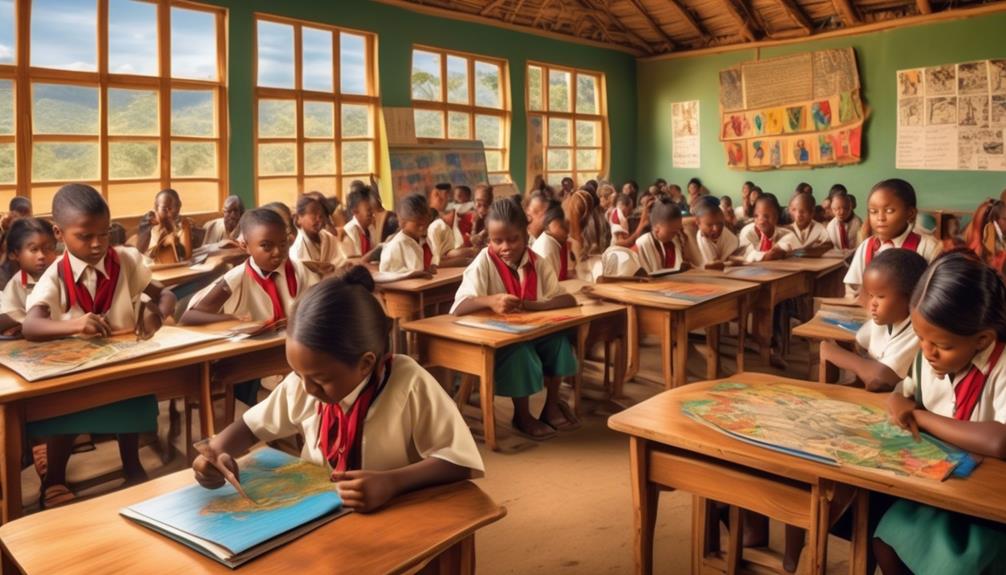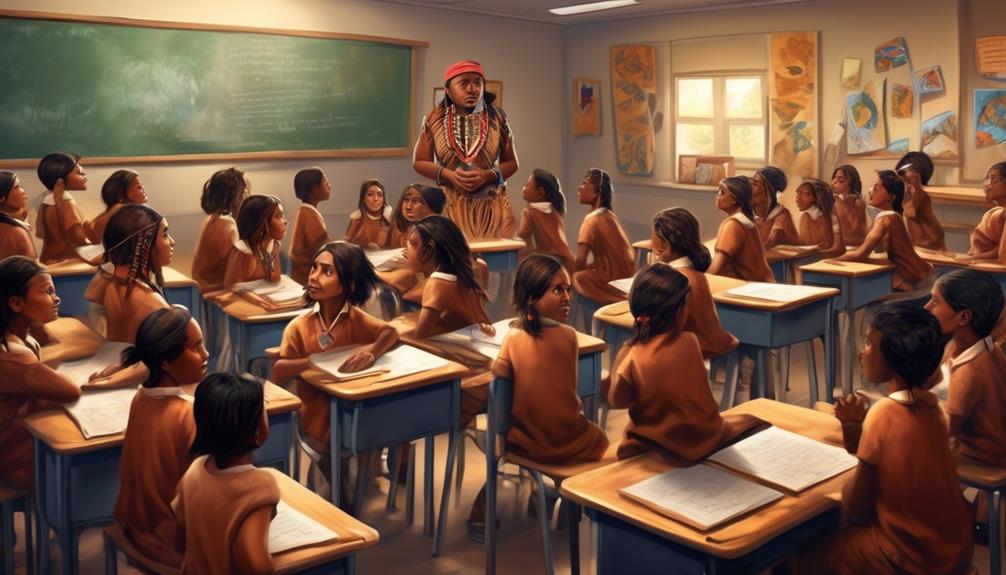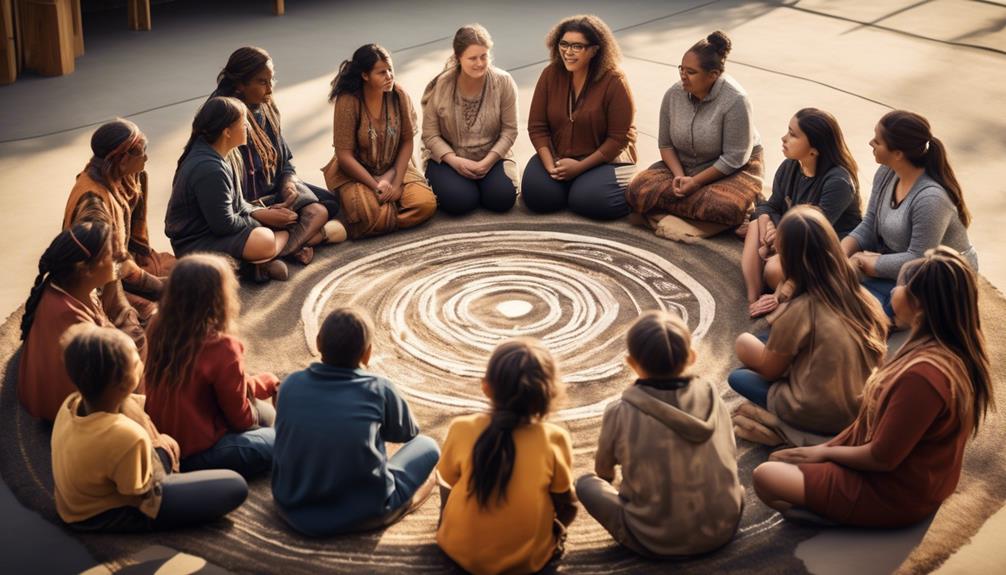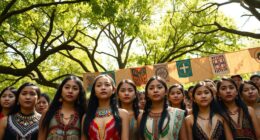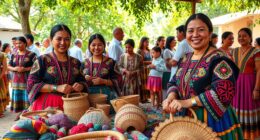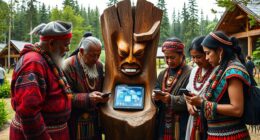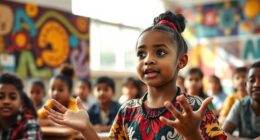There has been a significant increase in the number of students at Areyonga School who are proficient in both English and Pitjantjatjara. This unique bilingual education program has sparked conversation and garnered interest from both teachers and academics.
As we explore the impact of bilingual education on the students of Areyonga, it becomes evident that this approach offers a host of benefits, not only academically, but also in terms of cultural preservation and community empowerment.
But what are the key factors contributing to the success of this program, and what challenges does it continue to face?
Key Takeaways
- Bilingual education at Areyonga School enhances cognitive skills, problem-solving abilities, and memory.
- It fosters cultural pride and identity for better employment opportunities.
- Bilingual education leads to higher academic achievement and better career prospects.
- It creates inclusive learning environments that celebrate indigenous language and culture.
Areyonga's Indigenous Language Preservation
Areyonga's Indigenous Language Preservation has been a critical aspect of the community's identity and heritage for decades. The Areyonga School initiated a bilingual program in 1973, recognizing the importance of educating children in both English and Pitjantjatjara, an Aboriginal language. This program has been pivotal in preserving the Pitjantjatjara language and nurturing the cultural heritage of the community.
Over the years, it has provided children with the opportunity to learn their own language and culture, ensuring that these valuable traditions are passed down to future generations.
Despite facing challenges, such as potential funding cuts and changing educational needs, the bilingual program has remained steadfast. The strong community support and the demonstrated success in developing reading and writing skills in the first language led to an agreement in 2011, securing the program's continuation.
Looking to the future, recruiting local staff and adapting to changing student needs will be vital in sustaining Areyonga's Indigenous Language Preservation. The commitment to bilingual education ensures that the Indigenous languages and traditions at the heart of Areyonga's identity endure for years to come.
Academic Advantages of Bilingual Education
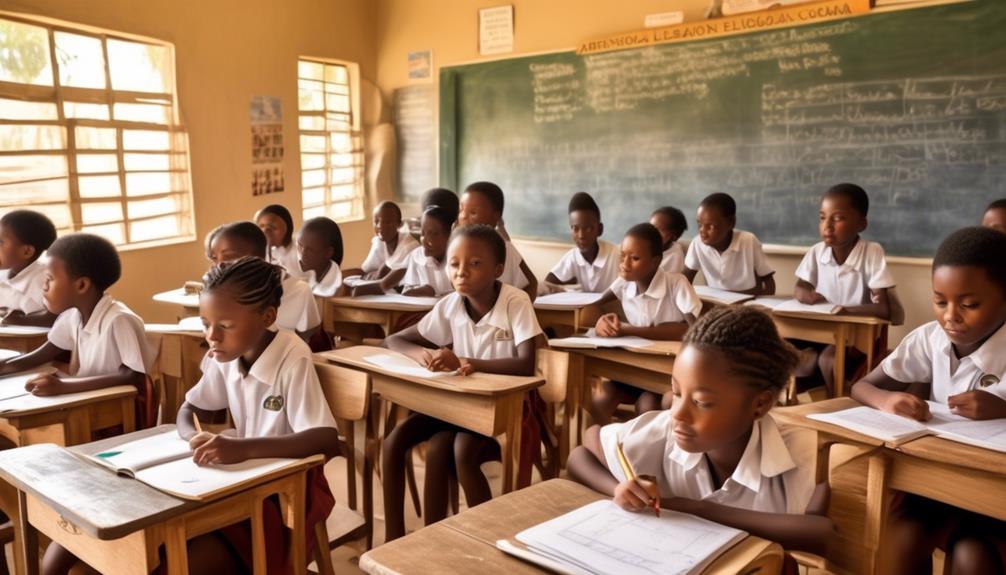
The success of Areyonga's bilingual program in preserving the Pitjantjatjara language and nurturing cultural heritage has been underscored by the academic advantages of bilingual education. This approach not only instills a sense of cultural pride and identity but also significantly enhances the academic performance of remote Aboriginal students. Principal Toby Brown, in collaboration with the NT Department of Education, has implemented a comprehensive bilingual education program tailored to the needs of Aboriginal children. This program incorporates teacher training, literacy skills development, and the preservation of language and culture within the formal education framework. Through bilingual education, students develop enhanced cognitive abilities, problem-solving skills, and improved memory, leading to higher academic achievement and better career prospects. The table below summarizes the academic advantages of bilingual education:
| Academic Advantages | Description |
|---|---|
| Enhanced Cognitive Skills | Bilingual education promotes confidence, cognitive abilities, and problem-solving skills in students. |
| Cultural Identity | Fosters cultural pride, identity, and better employment opportunities. |
| Improved Communication | Multilingual individuals have improved memory, multitasking, and communication skills. |
| Higher Academic Achievement | Bilingual education has led to higher academic achievement, better career prospects, and inclusive learning environments. |
Bilingual education not only benefits the individual students but also contributes to the preservation of languages and cultures, creating inclusive learning environments for all.
Community Empowerment Through Bilingualism
With the bilingual program at Areyonga School celebrating its 50th anniversary, our community has been profoundly empowered through the preservation of indigenous languages and cultures. The bilingual program hasn't only preserved the Pitjantjatjara language but also provided our students with the opportunity to learn their own language and culture. This has been essential in maintaining the identity and heritage of the Areyonga Community.
The success of the program in developing reading and writing skills in the first language has further strengthened the sense of pride and belonging among our indigenous peoples.
Looking towards the future, our main challenge lies in recruiting enough local staff to support the bilingual education program. However, the unwavering support from the community ensures that we're committed to maintaining language and cultural education for the generations to come.
The bilingual program isn't just about language; it's about empowerment, identity, and the future of the Torres Strait Islander and Northern Territory's Aboriginal communities. Through this program, we're building a stronger and more confident community, ready to face the challenges and opportunities of tomorrow.
Challenges and Successes of Bilingual Instruction

Celebrating 50 years of preserving indigenous languages and cultures through bilingual education at Areyonga School, we've encountered both challenges and successes in implementing this vital program.
The bilingual program, which began in 1973, has been instrumental in developing reading and writing skills in the Pitjantjatjara language. However, in 1998, the NT government's decision to phase out bilingual programs posed a significant challenge. This led to community protests, funding cuts, and legal challenges. Despite these obstacles, an agreement in 2011, with strong community support, ensured the continuation of the program.
One of the ongoing challenges is the recruitment of local staff to support the program. The current principal emphasizes the importance of a community-driven approach for the program's success. Former staff members celebrated the program's 50th anniversary, highlighting its enduring support within the community.
Looking ahead, the future focus is on maintaining language and cultural education. Bilingual education not only preserves indigenous languages but also fosters cultural pride and identity, enhancing cognitive abilities and problem-solving skills. It provides better future employment opportunities and promotes global understanding and cultural awareness.
In the face of challenges, the successes of Areyonga's bilingual program are a testament to its ongoing importance in the Northern Territory's Aboriginal and First Nations communities.
Future Prospects for Bilingual Education in Areyonga
After overcoming significant challenges and securing community support, we are now looking towards the future prospects for bilingual education in Areyonga. The Areyonga School has been a pioneer in introducing bilingual education, preserving the Northern Territory's Aboriginal languages, and fostering cultural pride. As we consider the future, it's essential to ensure the sustainability and growth of the bilingual program. We believe that the future of both-ways learning, incorporating both the Aboriginal and Torres Strait Islander languages and the English language, lies in adapting to changing needs and exploring new strategies and technologies.
To better illustrate the future prospects for bilingual education in Areyonga, let's consider the following:
| Future Prospects | Actions |
|---|---|
| Sustaining Language Preservation | Recruiting and retaining local staff to support the program |
| Strengthening Cultural Pride | Collaborating with the Department of Education to secure resources |
| Adapting to Changing Needs | Introducing bilingual literacy programs |
| Embracing Technology | Incorporating digital tools for language and cultural education |
The future of bilingual education at Areyonga School hinges on maintaining language and cultural education while adapting to the evolving educational landscape and community needs.
Frequently Asked Questions
What Is the Controversy Over Bilingual Education?
The controversy over bilingual education stems from differing views on language acquisition, cultural preservation, academic achievement, and educational equity. Parental involvement, funding allocation, and teacher training also impact the debate.
Socio-economic impact is a significant consideration, as the benefits of bilingual education extend beyond individual cognitive development. Striving for educational equity and serving others through effective bilingual programs requires a comprehensive understanding of these complex factors.
What Is the Bilingual Education Approach?
Language acquisition through bilingual education involves several key components. One of these components is cultural immersion, where students are exposed to the culture associated with the language they are learning. This immersion helps students develop a deeper understanding and appreciation for the language and its cultural context.
Another important aspect of bilingual education is fostering cognitive development. Research has shown that learning multiple languages can improve cognitive abilities such as problem-solving skills, critical thinking, and creativity. Bilingual education provides students with the opportunity to develop these cognitive skills while simultaneously learning a new language.
In addition to cultural immersion and cognitive development, bilingual education also promotes linguistic diversity. By encouraging the learning and use of multiple languages, this approach celebrates and preserves the diversity of languages around the world. This is especially important in a globalized society where multilingual communication is becoming increasingly valuable.
Furthermore, bilingual education promotes educational equity. It provides students who come from non-English speaking backgrounds with the opportunity to access education on par with their English-speaking peers. By providing instruction in both their native language and English, bilingual education ensures that these students have equal access to educational opportunities and resources.
Finally, bilingual education enhances language proficiency by reaping the benefits of bilingualism. Research has consistently shown that individuals who are bilingual have better language skills overall. Bilingual education employs effective language learning strategies that help students develop strong language proficiency in both their native language and the language they are learning.
What Is the Current Status of Bilingual Education in the Us?
We've seen significant progress in bilingual education in the US. This progress has been driven by a focus on language acquisition, cultural integration, and academic achievement. Our emphasis on language proficiency, parental involvement, and teacher training has played a key role in empowering students.
Additionally, community support has been crucial in preserving languages and ensuring the success of bilingual education programs. We recognize the importance of maintaining this momentum and building on our achievements.
At the core of our approach is a language policy that reflects our commitment to serving others and preserving diverse cultures. We believe that by supporting bilingual education, we are not only providing students with valuable skills but also fostering an inclusive and enriched learning environment for all.
What Is Bilingual Education Curriculum?
Bilingual education curriculum encompasses language acquisition, cultural integration, and academic success through dual language instruction. It fosters language development, biliteracy skills, and linguistic diversity while preserving languages and offering cognitive benefits.
The program promotes language immersion and supports the preservation of diverse linguistic heritages. With community involvement, bilingual education provides a holistic approach to learning, preparing students to thrive in multicultural settings and contribute to a more inclusive society.
Conclusion
So, is bilingual education really worth it?
The evidence from Areyonga School speaks for itself. The program hasn't only preserved the Pitjantjatjara language but has also improved academic outcomes for students.
With strong community support and a focus on maintaining language and cultural education, the future of bilingual education at Areyonga looks promising.
It's clear that bilingual education isn't just valuable, but essential for the empowerment of Indigenous communities.
Nayeli is our dedicated Editor in Chief, bringing her passion for words and keen editorial eye to every piece of content we produce. With years of experience in the field, she ensures that every article and publication meets the highest standards of quality and clarity. Nayeli’s commitment to storytelling and her deep understanding of our mission make her an invaluable leader in our team.
